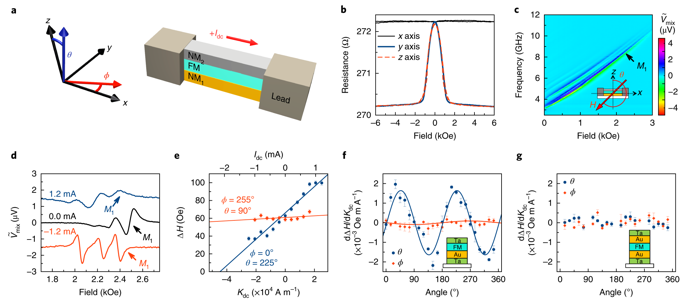Nature Nanotechnology ( IF 38.1 ) Pub Date : 2018-10-29 , DOI: 10.1038/s41565-018-0282-0 Christopher Safranski , Eric A. Montoya , Ilya N. Krivorotov

|
Spin–orbit torques (SOTs) in multilayers of ferromagnetic (FM) and non-magnetic (NM) metals can manipulate the magnetization of the FM layer efficiently. This is employed, for example, in non-volatile magnetic memories for energy-efficient mobile electronics1,2 and spin torque nano-oscillators3,4,5,6,7 for neuromorphic computing8. Recently, spin torque nano-oscillators also found use in microwave-assisted magnetic recording, which enables ultrahigh-capacity hard disk drives9. Most SOT devices employ spin Hall10,11 and Rashba12 effects, which originate from spin–orbit coupling within the NM layer and at the FM/NM interfaces, respectively. Recently, SOTs generated by the anomalous Hall effect in FM/NM/FM multilayers were predicted13 and experimentally realized14. The control of SOTs through crystal symmetry was demonstrated as well15. Understanding all the types of SOTs that can arise in magnetic multilayers is needed for a formulation of a comprehensive SOT theory and for engineering practical SOT devices. Here we show that a spin-polarized electric current known to give rise to anisotropic magnetoresistance (AMR) and the planar Hall effect (PHE) in a FM16 can additionally generate large antidamping SOTs with an unusual angular symmetry in NM1/FM/NM2 multilayers. This effect can be described by a recently proposed magnonic mechanism17. Our measurements reveal that this torque can be large in multilayers in which both spin Hall and Rashba torques are negligible. Furthermore, we demonstrate the operation of a spin torque nano-oscillator driven by this SOT. These findings significantly expand the class of materials that exhibit giant SOTs.
中文翻译:

由平面霍尔电流驱动的自旋轨道转矩
铁磁(FM)和非磁(NM)金属多层中的自旋轨道转矩(SOT)可以有效地控制FM层的磁化。例如,在用于节能移动电子产品1,2的非易失性磁性存储器中以及用于神经形态计算8的自旋扭矩纳米振荡器3,4,5,6,7中采用了这种方法。最近,自旋扭矩纳米振荡器也被用于微波辅助磁记录中,这使得超高容量硬盘驱动器9成为可能。大多数SOT设备采用自旋Hall 10,11和Rashba 12效应分别来自NM层内和FM / NM界面上的自旋轨道耦合。最近,由FM / NM / FM多层中的异常霍尔效应产生的SOT被预测13并通过实验实现14。通过晶体对称性控制SOTs也得到了证实15。了解全面的SOT理论和工程实用SOT器件需要了解磁性多层中可能出现的所有SOT类型。在这里,我们表明,自旋极化电流已知引起各向异性磁阻(AMR)和在FM平面霍尔效应(PHE)16可以附加地产生在NM用一个不寻常的角度对称大antidamping SOTS 1/ FM / NM 2多层。这种效果可以通过最近提出的强磁机构17来描述。我们的测量结果表明,在自旋霍尔和Rashba转矩均可以忽略的多层结构中,该转矩可能很大。此外,我们演示了由该SOT驱动的自旋扭矩纳米振荡器的操作。这些发现极大地扩展了展现巨型SOT的材料类别。











































 京公网安备 11010802027423号
京公网安备 11010802027423号